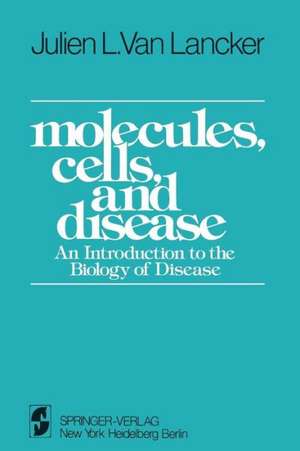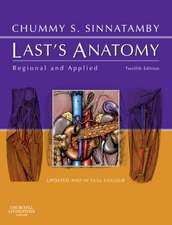Molecules, Cells, and Disease: An Introduction to the Biology of Disease: Springer Study Edition
Autor J.L. VanLanckeren Limba Engleză Paperback – 17 aug 1977
Din seria Springer Study Edition
-
 Preț: 386.26 lei
Preț: 386.26 lei -
 Preț: 370.79 lei
Preț: 370.79 lei -
 Preț: 296.06 lei
Preț: 296.06 lei -
 Preț: 403.37 lei
Preț: 403.37 lei -
 Preț: 508.91 lei
Preț: 508.91 lei - 23%
 Preț: 921.30 lei
Preț: 921.30 lei -
 Preț: 403.37 lei
Preț: 403.37 lei -
 Preț: 389.70 lei
Preț: 389.70 lei - 15%
 Preț: 502.73 lei
Preț: 502.73 lei -
 Preț: 389.70 lei
Preț: 389.70 lei - 5%
 Preț: 1122.94 lei
Preț: 1122.94 lei -
 Preț: 406.25 lei
Preț: 406.25 lei - 15%
 Preț: 530.58 lei
Preț: 530.58 lei -
 Preț: 398.35 lei
Preț: 398.35 lei - 5%
 Preț: 368.73 lei
Preț: 368.73 lei - 15%
 Preț: 633.02 lei
Preț: 633.02 lei -
 Preț: 392.75 lei
Preț: 392.75 lei - 15%
 Preț: 588.69 lei
Preț: 588.69 lei - 20%
 Preț: 660.99 lei
Preț: 660.99 lei - 20%
 Preț: 663.61 lei
Preț: 663.61 lei - 15%
 Preț: 640.88 lei
Preț: 640.88 lei - 15%
 Preț: 654.43 lei
Preț: 654.43 lei -
 Preț: 390.46 lei
Preț: 390.46 lei - 15%
 Preț: 652.81 lei
Preț: 652.81 lei -
 Preț: 394.87 lei
Preț: 394.87 lei - 15%
 Preț: 642.03 lei
Preț: 642.03 lei - 15%
 Preț: 688.99 lei
Preț: 688.99 lei - 15%
 Preț: 642.36 lei
Preț: 642.36 lei - 15%
 Preț: 635.15 lei
Preț: 635.15 lei -
 Preț: 396.62 lei
Preț: 396.62 lei - 18%
 Preț: 893.21 lei
Preț: 893.21 lei -
 Preț: 419.14 lei
Preț: 419.14 lei -
 Preț: 423.34 lei
Preț: 423.34 lei - 20%
 Preț: 377.27 lei
Preț: 377.27 lei - 18%
 Preț: 742.97 lei
Preț: 742.97 lei - 15%
 Preț: 655.27 lei
Preț: 655.27 lei - 20%
 Preț: 336.02 lei
Preț: 336.02 lei -
 Preț: 397.38 lei
Preț: 397.38 lei
Preț: 370.38 lei
Preț vechi: 389.88 lei
-5% Nou
Puncte Express: 556
Preț estimativ în valută:
70.89€ • 77.03$ • 59.59£
70.89€ • 77.03$ • 59.59£
Carte tipărită la comandă
Livrare economică 21 aprilie-05 mai
Preluare comenzi: 021 569.72.76
Specificații
ISBN-13: 9780387902425
ISBN-10: 0387902422
Pagini: 311
Ilustrații: 311 p. 28 illus.
Dimensiuni: 155 x 235 x 18 mm
Greutate: 0.46 kg
Ediția:1977
Editura: Springer
Colecția Springer
Seria Springer Study Edition
Locul publicării:New York, NY, United States
ISBN-10: 0387902422
Pagini: 311
Ilustrații: 311 p. 28 illus.
Dimensiuni: 155 x 235 x 18 mm
Greutate: 0.46 kg
Ediția:1977
Editura: Springer
Colecția Springer
Seria Springer Study Edition
Locul publicării:New York, NY, United States
Public țintă
ResearchCuprins
1 The Concept of Disease and Its History.- Prehistoric Times.- Egypt, Greece, and Rome.- Medieval Times.- The Foundation of Modern Pathology.- Cellular Pathology.- The Origins of Chemical Pathology.- 2 Development of Existing Knowledge.- Gene Expression.- Cell Structure.- Intercellular Integration.- Conclusion.- 3 Defense Mechanisms.- First Line of Defense.- Blood Coagulation, Inflammation, and Immunity.- Restoration of Lost Tissues.- 4 Causes of Disease.- Hereditary Diseases.- Congenital Anomalies.- Conflict with the Environment.- Nutritional Deficiencies.- Hormonal Imbalances.- Body Fluids and Electrolyte Imbalances.- Defective Defense Mechanisms.- Excessive Response to Injury.- Conclusion.- 5 Injuries to Units of Specificity.- Primary Injury to DNA.- DNA Repair.- Consequences of Injuries to DNA.- Inherited Mutations.- Somatic Mutations.- Interference with DNA Synthesis.- Injuries to Transcription.- Pathology of Translation.- Conclusion.- 6 Injuries to Catalytic Units.- About Atoms and Molecules.- About Chemical Reactions.- About Enzyme Reactions.- Life Cycle of Enzymes.- Pathology of the Catalytic Unit.- Disease and Substrate Alteration.- Conclusion.- 7 Hormone Imbalance.- Endocrine Glands.- Mode of Action of Hormones.- Regulation of Hormone Secretion.- Second Messengers.- Hormone Degradation.- Hormonal Diseases.- 8 Pathology of Cell Membranes.- Function of the Plasma Membrane.- Structure of Cell Membranes.- Molecular Organization of the Cell Membrane.- Biosynthesis of the Cell Membrane.- The Cytocavitary Network.- Pathology of Cell Membranes.- Conclusion.- 9 Reflections on Cellular Death.- Primary, Secondary, and Critical Injuries.- Programmed Death.- Provoked Death.- Conclusion.- 10 The Great Killers, Atherosclerosis and Cancer.- Atherosclerosis.- Cancer.- 11 Aging.- Manifestations of Aging.- Possible Cellular Mechanisms in Aging.- Biological Causes of Aging.- Conclusion.












